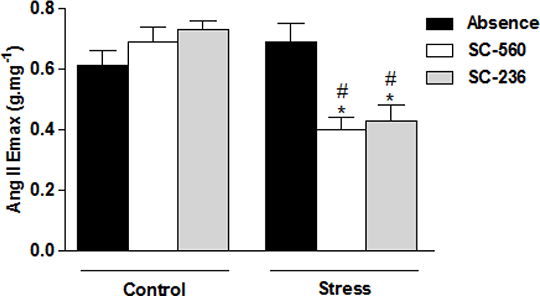The Role of Cyclooxigenases-derived Metabolites on the Contraction Induced by Angiotensin II in Carotid Artery from Rat Exposed to Stress Cyclooxygenase (COX) isoforms are involved in sympathetic activation due to restraint stress (1). COXs-derived metabolites modulate angiontensin (Ang) II-induced contraction in diabetic rat carotid artery (2). The aim of this study was to investigate the role of COX-1- and COX-2-derived metabolites on the contraction evoked by Ang II in carotid artery in rats exposed to restraint stress. Adult male Wistar rats (n≥8) were exposed or not to 3h restraint stress for 5 days and experiments were performed on day 5. Concentration-response curves for Ang II were obtained in carotid rings with or without endothelium from control (C) or exposed to restraint stress (RS) rats, in the presence of COX-1 or COX-2 selective inhibitor [SC-560 (9nmol/L) or SC-236 (10nmol/L), respectively]. Protein expression was assessed by western blot in carotid artery from both groups. SC-560 e SC-236 reduced the maximum effect (Emax) for Ang II in endothelium-intact carotids RS rat when compared to the control group (Fig. 1). In the absence of endothelium, the selective inhibitors of COX isoforms did not alter the Ang II Emax in RS rat carotid arteries compared to the control group (SC-560: 1.06±0.07 vs. 1.20±0.07g/mg; SC-236: 1.17±0.08 vs.1.40±0.05g/mg). Repeated restraint stress enhaced the protein expression of COX-1 in rat carotid arteries and it did not alter the protein expression of COX-2 (Fig. 2). 
Fig. 1 Effect of COX inhibitors on Ang II Emax in carotid from control and stress rats. *p<0.05 vs. stress in absence of inhibitors. #p<0.05 vs. respective control. Anova one-way; Bonferroni. 
Fig. 2 Effect of stress on the expression of COX isoforms in carotid from rats. *p<0.05 vs. control. Test t nonparametric; Mann Whitney. It was also observed that endothelium-dependent metabolites derived from COX-1 and COX-2 showing contractile properties participate in the modulation of the contraction induced by Ang II of rats kept under RS conditions. This participation is restricted to animals exposed to stress and it seems to be mediated by increased protein expression of COX-1 in this group. Given that the expression of COX-2 in the carotids was similar between RS and control rat, we can suggest that alterations on the activity might lead to the distinct role of its metabolites on Ang II-induced contraction in RS rat carotid. (1) Yamaguchi N et al, Neuroscience 170:773-781, 2010 (2) Pernomian L et al, Eur J Pharmacol 678:15–25, 2012 |



.gif)